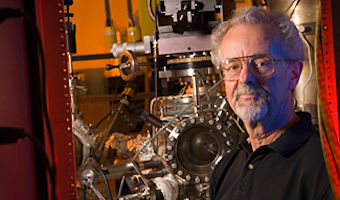The Physics & Astronomy Colloquium Series presents Ward Plummer, of Louisiana State University, on “Hidden Bulk Phases Revealed by Broken Symmetry at a Surface” on Friday, March 2, at 4:10 p.m. in Walter 245.

Ward Plummer
Abstract: If you have taught or attended a condensed matter physics course, you know that the subjects are compartmentalized: lattice structure, electronic structure, lattice dynamics, magnetism and superconductivity. The modern world of functional materials is not compartmentalized; it is the nonlinear entanglement of lattice, electron, and spin degrees of freedom that creates functionality, such as superconductivity, magnetoresistance, quantum criticality, etc.. Functional materials respond to external and internal stimuli, like temperature, pressure, field, or doping. The goal of materials research is to learn to manipulate, control, or design the desired functionality. One way to reveal new (hidden) phases in bulk is to explore the functionality of surfaces in an environment of broken symmetry. Our group has investigated the surface properties of many complex materials, including Fe-based superconductors.
In this talk, I will describe the surface properties of Mn-doped double layered ruthenate, Sr3Ru2O7. The bulk parent compound is a paramagnetic metal, but pressure creates a ferromagnetically ordered state and magnetic field drives the material into a quantum critical state. Mn doping creates a metal-insulator transition and a long range, antiferromagnetically (AFM) ordered state at low temperatures. The surface, because of structural reconstruction, displays fundamentally different behavior from bulk—insulating when the bulk is conducting and visa versa. Most intriguing is the observation that at the Mn doping where AFM exists in the bulk (low temperatures), AFM order removes the surface reconstruction and results in a surface metal-to-insulator transition resembling a Slater transition, not a Mott transition. Our work shows that creating a surface by breaking the translational symmetry is an effective way to reveal hidden phases non-existent in bulk.
















Comments